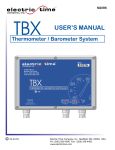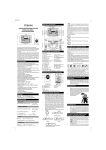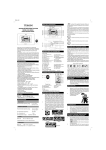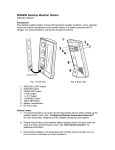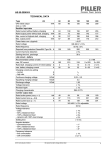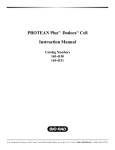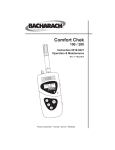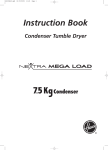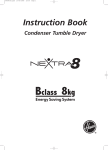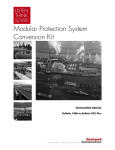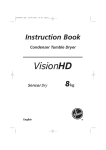Download DWYER INSTRUMENTS, INC. phone: 219/879-8000
Transcript
Bulletin AQ-CDT Series CDT Carbon Dioxide/Temperature Transmitter Specifications - Installation and Operating Instructions 35/64 [13.89] 3x 3/8 [9.53] 1-3/16 [30.20] 1-3/16 [30.20] 1-13/32 [35.72] 4-31/64 [113.9] 7/8 [22.35] 4x 3/16 [4.76] 1-53/64 [46.43] 3-13/32 [86.52] Series CDT Carbon Dioxide and Temperature Transmitters accurately monitor the CO2 concentration and temperature in schools, office buildings, and other indoor environments to help achieve LEED® certification. For increased sensor life, a single-beam dual-wavelength non-dispersive infrared (NDIR) sensor is used to automatically correct the measurement in both occupied and unoccupied buildings against aging effects. The single-beam dual-wavelength sensor technology provides the highest level of accuracy compared to Automatic Baseline Correction methods which can unintentionally shift the calibration based on CO2 levels and barometric pressure conditions. In order to achieve a higher level of accuracy, the Series CDT includes digital barometric pressure adjustment and the ability to field-calibrate the sensor. Universal outputs allow users to select the transmitter output to be 4 to 20 mA, 0 to 5 VDC or 0 to 10 VDC to work with virtually any building management controller. An optional relay with user adjustable set points can be used to control exhaust fans, open actuated windows or dampers, or signal a light or horn. For applications that require visual indication, the Series CDT can be ordered with an integral LCD display or the Model A-449 remote LCD display that can plug into the mini-connector port on the side of the transmitter. The display can be configured to display temperature only, CO2 only or CO2 and temperature together. Push buttons are standard on the transmitters for access to the menu structure, but the transmitter can be ordered without the buttons. To prevent tampering, the action of the buttons can be locked out using an internal jumper selection. Menu items that can be accessed include: engineering units, relay output set points, display configuration, transmitter output scaling, ambient barometric pressure and field calibration of the transmitter. Single beam dual-wavelength sensor advantages: • Automatically corrects for aging effects in occupied and unoccupied buildings o Perfect for hospitals and manufacturing plants that are occupied 24 hours per day • Measures actual unfiltered light intensity directly o Eliminates error from incorrect assumptions of gas concentration in theoretical logic assumption methods 1-13/32 [50.01] SpECIfICATIONS Range: CO2: 0 to 2000 or 0 to 5000 ppm (depending on model); Temperature: 32 to 122°F (0 to 50°C). Accuracy: ±40 ppm + 3% of reading. Temperature Dependence: ±8 ppm / °C at 1100 ppm. Non-Linearity: 16 ppm. pressure Dependence: 0.13% of reading per mm of Hg. Response Time: 2 minutes for 99% step change. Ambient Operating Temperature: 32 to 122°F (0 to 50°C). Ambient Operating Humidity: 10 to 95% RH (non-condensing). power Requirements: 16 to 35 VDC / 19 to 28 VAC. power Consumption: Average: 2 watts; Peak: 3.75 watts. Sensor: Single beam, dual-wavelength NDIR. Output: Current: 4 to 20 mA (max 500 Ω); Voltage: 0 to 5 VDC or 0 to 10 VDC (min 500 Ω); Relay: SPST NO 2A @ 30 VDC; RTD or thermistor per r-t curves (depending on model). Weight: 5.6 oz (158.8 g). INSTALLATION WARNING Disconnect power supply before installation to prevent electrical shock and equipment damage. Make sure all connections are in accordance with the job wiring diagram and in accordance with national and local electrical codes. Use copper conductors only. CAUTION Use electrostatic discharge precautions (e.g., use of wrist straps) during installation and wiring to prevent equipment damage. CAUTION Avoid locations where severe shock or vibration, excessive moisture or corrosive fumes are present. CAUTION Do not exceed ratings of this device, permanent damage not covered by warranty may result. NOTICE Upon powering the transmitter, the firmware version will flash on the display. A warm up period of 30 minutes is required for the transmitter to adjust to the current CO2 concentration. NOTICE DWYER INSTRUMENTS, INC. p.O. BOX 373 • MICHIGAN CITY, INDIANA 46361, U.S.A. Self calibration feature of the transmitter requires exposure to normal outdoor equivalent carbon dioxide level once every thirty days. phone: 219/879-8000 fax: 219/872-9057 www.dwyer-inst.com e-mail: [email protected] HINGE TO REMOVE COVER APPLY PRESSURE TO BOTTOM TAB WHERE INDICATED AND THE TWO PARTS WILL BECOME UNHINGED AT TOP Current / Voltage Outputs The transmitter may be wired for current or voltage output for both carbon dioxide and temperature. The transmitter can be powered with either 16 to 35 VDC or 19 to 28 VAC. Wire the transmitter according to Figure 5. MOUNTING BACK PLATE MOUNTING SCREWS NOTICE Optional relay can be used as either a dry contact or low voltage switched circuit up to 2 A at 30 VDC. REVERSE PROCESS TO APPLY COVER POWER TEMPERATURE SUPPLY RECEIVER CO2 BOTTOM TAB RECEIVER SELF-LATCHING COVER fIGURE 1: Removal Of Cover from Back plate WIRING Use maximum 18 AWG wire for wiring to terminals. Refer to Figure 5 for wiring information. 3 4 5 OUT2 RLY 6 RLY 2 COM PWR 1 OUT1 RELAY CONTACT MOUNTING 1. Push tab on bottom of cover and lift cover from back plate (See Figure 1). 2. Select the mounting location, away from diffusers, lights or any external influences. 3. Mount transmitter on a vertical surface to a standard electrical box using the two #6 M2C type screws provided. 4. Pull wires through sub base hole and make necessary connections. 5. Reattach cover to base plate. fIGURE 5: Active Output Wiring Diagram Thermistor and RTD Outputs Thermistor and RTD passive outputs are located on the back plate and do not require any power. Passive temperature outputs are not polarity sensitive. Remote Display For models that are ordered without an integral LCD display, remote display Model A-449 can be used to display the temperature and carbon dioxide. The mini USB plug of the remote display plugs into the receptor on the side of the housing. After a short warm up time, the display will begin to show the current temperature and carbon dioxide measurements unless configured by the user to show only temperature or only carbon dioxide. PJ2 PJ4 PJ5 EDITING MENU pARAMETERS Before any adjustment can be made to the transmitter, the Menu Lockout Jumper (PJ4) must be set to the ˝On˝ position (See Figure 6). PJ1 fIGURE 2: Diagram Of Circuit Board Selection of Current and Voltage Outputs Prior to wiring, verify that the current/voltage selection jumpers (PJ1, PJ2, and PJ5) are set to the desired output type. Refer to Figure 2 to locate the selection jumpers. See Figure 3 for diagram of the current/voltage selection jumper. For voltage output selection, the output can be 0 to 10 VDC, 0 to 5 VDC, 2 to 10 VDC or 1 to 5 VDC. See Figure 4 for the type of voltage output selection jumper (PJ5). CURRENT OUTPUT MENU MENU PJ4 V PJ4 ON OFF fIGURE 6: Menu Lockout Jumper ACCESSING MENU pARAMETERS Step 1: To enter the menu structure, press and 5 seconds (display will show RON parameter). VOLTAGE OUTPUT C DISABLED ON OFF Step 2: Press C V ENABLED or simultaneously for to cycle between menu items. Step 3: Press to edit the value for the displayed menu item (SET will appear on display). F fIGURE 3: Current/Voltage Output Selection Jumper (pJ1 And pJ2) Step 4: Press Step 5: Press or to adjust the value of the menu item. to save the changes (SET will disappear). Step 6: Repeat Steps 2 through 5 for each of the parameters. 2 to 10 V 4 to 20 mA 0 to 10 V 0 to 20 mA 0 to 5 V 0 to 10 mA fIGURE 4: Output Range Selection Jumper F 1 to 5 V 2 to 10 mA Step 7: To exit the menu at any time, press and hold and simultaneously for 5 seconds or wait 10 seconds without pushing any buttons. Menu Descriptions RON Relay on set point Sets the CO2 concentration which the optional relay is energized. Low limit: Factory setting: High limit: 0 PPM 1000 PPM 2000/5000 PPM (depending on model) ROf Relay off set point Sets the CO2 concentration which the optional relay is de-energized. Setting value lower than RON provides direct action for detecting high concentrations of CO2. Setting value higher than RON provides indirect action for detecting low or on the LCD display will be lit to indicate concentrations of CO2. when the relay is energized. Low limit: Factory setting: High limit: 0 PPM 950 PPM 2000/5000 PPM (depending on model) DSp Display configuration Determines the LCD display configuration during normal operation. The LCD display can indicate the CO2 concentration and the temperature, the CO2 concentration only or the temperature only. The factory default is to display both the temperature and the CO2 concentration. CT C T UNI CO2 concentration and temperature CO2 concentration only Temperature only Units selection Temperature and barometric pressure measurements can be displayed in US engineering units or SI engineering units. The factory default is to display US engineering units. US units SI units F for temperature and in Hg for barometeric pressure C for temperature and hPa for barometric pressure COL CO2 low output range Sets the CO2 concentration for the lowest output (4 mA or 0 VDC). Low limit: Factory setting: High limit: 0 PPM 0 PPM 2000/5000 PPM (depending on model) COH CO2 high output range Sets the CO2 concentration for the highest output (20 mA, 5 VDC or 10 VDC). When COH is set above COL, the transmitter is direct acting and the output will increase with an increase in CO2 level. When COH is below COL, the transmitter is reverse acting and the output will increase with a decrease in CO2 level. Low limit: 0 PPM Factory setting: 2000/5000 PPM (depending on model) 2000/5000 PPM (depending on model) High limit: TOL Temperature low output range Sets the temperature for the lowest output (4 mA or 0 VDC). Low limit: Factory setting: High limit: 32.0°F / 0.0°C 32.0°F / 0.0°C 122.0°F / 50.0°C TOH Temperature high output range Sets the temperature for the highest output (20 mA, 5 VDC or 10 VDC). When TOH is set above TOL, the transmitter is direct acting and the output will increase with an increase in temperature. When TOH is below TOL, the transmitter is reverse acting and the output will increase with a decrease in temperature. Low limit: Factory setting: High limit: 32.0°F / 0.0°C 122.0°F / 50.0°C 122.0°F / 50.0°C BAR Barometric pressure Sets the typical barometric pressure for the location where the transmitter is mounted. The factory setting is for standard pressure at sea level. Adjusting the barometric pressure gives a more accurate measurement, especially at higher elevations. Refer to the elevation charts in Figure 9 for typical barometric pressures at a given elevation. Low limit: Factory setting: High limit: 20.0 in Hg / 600 hPa 29.9 in Hg / 1013 hPa 32.0 in Hg / 1100 hPa CAL Calibration Calibrates the carbon dioxide sensor to a known gas value. Read calibration instructions before using this feature. Hold for 5 seconds. CALIBRATING SENSOR Step 1: Remove the cover as shown in Figure 1. Step 2: Slide the calibration tubing through the slots on the back plate and attach to one of the nipples on the CO2 sensor (See Figure 7). Step 3: Carefully re-attach the cover to the back plate without pinching the tubing between the back plate and the cover. Step 4: Follow the steps in the accessing parameter section to access the calibration parameter (CAL). button. Step 5: Press the Step 6: Flow zero reference gas at 0.3 SLPM for 5 minutes. Step 7: Press and hold the button for 3 seconds. Step 8: Flow the full scale reference gas at 0.3 SLPM for 5 minutes. Step 9: Press and hold the button for 3 seconds. Step 10: Exit the parameter menu. Step 11: Remove cover as shown in Figure 1. Step 12: Remove tubing from sensor and re-attach the gas nipple cover to the sensor. Step 13: Re-attach the cover to the back plate. MAINTENANCE Upon final installation of the Series CDT Carbon Dioxide Transmitter and the companion receiver, no routine maintenance is required. A periodic check of the system calibration is recommended. The Series CDT is not field serviceable and should be returned if repair is needed (field repair should not be attempted and may void warranty). Be sure to include a brief description of the problem plus any relevant application notes. Contact customer service to receive a return goods authorization number before shipping. CO2 SENSOR fIGURE 7: Calibration CDT -2 W 4 4 -LCD 2 5 W Configuration 4 CO2 Output 0 Temperature 4 Output A B C D E F LCD Options RLY NBC Series Range Example: CDT-2W44-LCD 0 to 2000 ppm CO2 range 0 to 5000 ppm CO2 range Wall 4 to 20 mA / 0 to (5 or 10) VDC None 4 to 20 mA / 0 to (5 or 10) VDC 10 KΩ NTC thermistor type III 10 KΩ NTC thermistor type II 3 KΩ NTC thermistor Pt100 Ω RTD Pt1000 Ω RTD 20 KΩ NTC thermistor LCD display Relay No buttons fIGURE 8: Model Chart fIGURE 9: Elevation Chart RESISTANCE Temperature °f °C -67.0 -55 -58.0 -50 -49.0 -45 -40.0 -40 -31.0 -35 -22.0 -30 -13.0 -25 -4.0 -20 5.0 -15 14.0 -10 23.0 -5 32.0 0 41.0 5 50.0 10 59.0 15 68.0 20 77.0 25 86.0 30 95.0 35 104.0 40 113.0 45 122.0 50 131.0 55 140.0 60 149.0 65 158.0 70 167.0 75 176.0 80 185.0 85 194.0 90 203.0 95 100 212.0 105 221.0 110 230.0 115 239.0 120 248.0 125 257.0 130 266.0 135 275.0 140 284.0 145 293.0 150 302.0 VS TEMpERATURE TABLE Resistance Curves (in Ohms) C B A 607800.00 963849.00 289154.70 441200.00 670166.00 201049.80 323600.00 471985.00 141595.50 239700.00 336479.00 100943.70 179200.00 242681.00 72804.30 135200.00 176974.00 53092.20 102900.00 130421.00 39126.30 78910.00 97081.00 29124.30 61020.00 72957.00 21887.10 47540.00 55329.00 16598.70 37310.00 42327.00 12698.10 9795.00 29490.00 32650.00 7617.60 23460.00 25392.00 5970.30 18780.00 19901.00 4713.60 15130.00 15712.00 3747.90 12260.00 12493.00 3000.00 10000.00 10000.00 2417.10 8057.00 8194.00 1959.30 6531.00 6752.00 1597.80 5326.00 5592.00 1310.40 4368.00 4655.00 1080.60 3602.00 3893.00 895.80 2986.00 3271.00 746.40 2488.00 2760.00 624.90 2083.00 2339.00 525.60 1752.00 1990.00 444.00 1480.00 1700.00 376.50 1255.00 1458.00 321.00 1070.00 1255.00 274.65 915.50 1084.00 235.98 786.60 939.30 203.58 678.60 816.80 176.28 587.60 712.60 153.18 510.60 623.60 133.59 445.30 547.30 116.88 389.60 481.80 102.57 341.90 425.30 90.30 301.00 376.40 79.74 265.80 334.00 70.59 235.30 297.20 62.67 208.90 265.10 55.83 186.10 237.00 D 78.32 80.31 82.29 84.27 86.25 88.22 90.19 92.16 94.12 96.09 98.04 100.00 101.95 103.90 105.85 107.79 109.74 111.67 113.61 115.54 117.47 119.40 121.32 123.24 125.16 127.08 128.99 130.90 132.80 134.71 136.61 138.51 140.40 142.29 144.18 146.07 147.95 149.83 151.71 153.58 155.46 157.33 f E 783.2 2394000.00 803.1 1646200.00 822.9 1145800.00 806800.00 842.7 574400.00 862.5 413400.00 882.2 300400.00 901.9 220600.00 921.6 163500.00 941.2 122280.00 960.9 92240.00 980.4 70160.00 1000.0 53780.00 1019.5 41560.00 1039.0 32340.00 1058.5 25360.00 1077.9 20000.00 1097.4 15892.00 1116.7 12704.00 1136.1 10216.00 1155.4 8264.00 1174.7 6722.00 1194.0 5498.00 1213.2 4520.00 1232.4 3734.00 1251.6 3100.00 1270.8 2586.00 1289.9 2166.00 1309.0 1822.60 1328.0 1540.00 1347.1 1306.40 1366.1 1112.60 1385.1 951.00 1404.0 815.80 1422.9 702.20 1441.8 606.40 1460.7 525.60 1479.5 N/A 1498.3 N/A 1517.1 N/A 1535.8 N/A 1554.6 N/A 1573.3 fIGURE 10: Resistance vs Temperature ©Copyright 2011 Dwyer Instruments, Inc. Printed in U.S.A. 3/11 DWYER INSTRUMENTS, INC. p.O. BOX 373 • MICHIGAN CITY, INDIANA 46361, U.S.A. phone: 219/879-8000 fax: 219/872-9057 FR# 06-443800-00 Rev. 2 www.dwyer-inst.com e-mail: [email protected]




